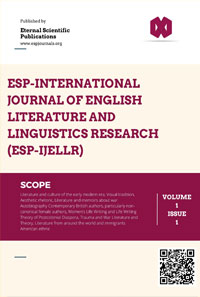ESP International Journal of English Literature and Linguistics Research (ESP-IJELLR)
Citation :
K. Nandhini, S. Gowri, 2025. "Neural Networks and Natural Language Processing in Automatic Sentiment Analysis of Social Media Texts" ESP-International Journal of English Literature and Linguistics Research (ESP- IJELLR) Volume 3, Issue 2: 31-41.
Abstract :
A vast resource of user generated content on peoples' thoughts, comments, emotions, and social interactions has appeared due to the rapid growth in social media platforms like Twitter, Facebook, Instagram and Reddit. In many areas, including industry, politics, medical care and sociology research, this huge amount of textual data is a priceless source for understanding public emotion, preference and behavior dynamics. The rich and unpredictable nature of social media data, filled with slang, colloquial terms, emoticons, acronyms and multilingual expressions and would therefore render a manual approach to sentiment analysis impractical. etc), automatic sentiment analysis, which is able to leverage the power of NLP techniques in conjunction with state-of-the-art neural network structures for accurate and effective sentiment classification has become an invaluable technique in the computational toolbelt. Learning complex, hierarchical text representations and capturing contextual dependencies that are critical for the interpretation of sentiment is one of the primary advantages of neural networks over traditional machine learning methods, especially deep learning architectures such as Convolutional Neural Networks (CNNs), Recurrent Neural Networks (RNNs) and Long Short-Term Memory (LSTM) models. Besides, by introducing word embeddings, attention mechanisms and hybrid architectures are employed to enhance the robustness of emotion classification models which can make them become more effective in capturing idiomatic expressions, subtle linguistic patterns and implicit subjective feelings. Despite these advances, challenges still remain in tackling irony, sarcasm, code-switching and domain-specific terms identification which all cause huge problems in sentiment prediction. In addition, issues such as data imbalance, noisy material and the evolving social media terminology demand continuous adaptation and enhancement of models. From the rise of lexicon based and rule-based methods to traditional machine learning, all the way up to modern deep learning approaches, this work presents a comprehensive account of the role played by neural networks within NLP inspired autonomous sentiment analysis. Significant neural network architectures are discussed as well along with their applicability in social media messages, and existing issues and solutions. The report demonstrates the transformative potential of neural network-based sentiment analysis through a comparative study against current methods as well as real-world applications in public health surveillance, political science, market research and brand monitoring. Results indicate that the application of deep learning in conjunction with NLP can help improve the accuracy of predictions, as well as provide more detailed insights into human emotion and online sentiment. This allows stakeholders to make decisions in a timely manner and with the benefit of some context and data. Beyond providing paths for future improvements to model interpretability, cross-domain adaptation, multimodal integration, and ethical deployment, this work contributes to broadening the understanding of how artificial intelligence can translate complex social data.
References :
[1] Cambria, E., & White, B. (2014). Jumping NLP curves: A review of natural language processing research. IEEE Computational Intelligence Magazine, 9(2), 48–57.
[2] Liu, B. (2012). Sentiment analysis and opinion mining. Synthesis Lectures on Human Language Technologies, 5(1), 1–167.
[3] Pang, B., & Lee, L. (2008). Opinion mining and sentiment analysis. Foundations and Trends in Information Retrieval, 2(1-2), 1–135.
[4] Zhang, L., Wang, S., & Liu, B. (2018). Deep learning for sentiment analysis: A survey. Wiley Interdisciplinary Reviews: Data Mining and Knowledge Discovery, 8(4), e1253.
[5] Kim, Y. (2014). Convolutional neural networks for sentence classification. EMNLP, 1746–1751.
[6] Hochreiter, S., & Schmidhuber, J. (1997). Long short-term memory. Neural Computation, 9(8), 1735–1780.
[7] Tang, D., Qin, B., & Liu, T. (2015). Document modeling with gated recurrent neural network for sentiment classification. EMNLP, 1422–1432.
[8] Devlin, J., Chang, M.-W., Lee, K., & Toutanova, K. (2019). BERT: Pre-training of deep bidirectional transformers for language understanding. NAACL-HLT, 4171–4186.
[9] Liu, P., Qiu, X., & Huang, X. (2016). Recurrent neural network for text classification with multi-task learning. IJCAI, 2873–2879.
[10] Socher, R., Perelygin, A., Wu, J., Chuang, J., Manning, C. D., Ng, A., & Potts, C. (2013). Recursive deep models for semantic compositionality over a sentiment treebank. EMNLP, 1631–1642.
[11] Tang, H., Qin, T., & Liu, T. (2015). Learning semantic representations of users and products for document level sentiment classification. ACL, 1014–1023.
[12] Ruder, S., Peters, M. E., Swayamdipta, S., & Wolf, T. (2019). Transfer learning in natural language processing. NAACL Tutorial.
[13] Poria, S., Cambria, E., Bajpai, R., & Hussain, A. (2017). A review of affective computing: From unimodal analysis to multimodal fusion. Information Fusion, 37, 98–125.
[14] Chen, H., Li, Y., Sun, X., & Li, H. (2020). Cross-domain sentiment classification with BERT. Knowledge-Based Systems, 192, 105406.
[15] Felbo, B., Mislove, A., Søgaard, A., Rahwan, I., & Lehmann, S. (2017). Using millions of emoji occurrences to learn any-domain representations for detecting sentiment, emotion, and sarcasm. EMNLP, 1615–1625.
[16] Cambria, E., Poria, S., Bajpai, R., & Schuller, B. (2016). SenticNet 4: A semantic resource for sentiment analysis. AAAI, 266–273.
[17] Zhang, Y., & Wallace, B. (2015). A sensitivity analysis of (and practitioners’ guide to) convolutional neural networks for sentence classification. arXiv preprint arXiv:1510.03820.
[18] Chen, T., & Guestrin, C. (2016). XGBoost: A scalable tree boosting system. KDD, 785–794.
[19] Agarwal, B., Mittal, N., & Liu, H. (2011). Sentiment analysis of Twitter data. WWW Companion, 607–608.
[20] Medhat, W., Hassan, A., & Korashy, H. (2014). Sentiment analysis algorithms and applications: A survey. Ain Shams Engineering Journal, 5(4), 1093–1113.
Keywords :
Convolutional Neural Networks (CNN), Recurrent Neural Networks (RNN), Opinion Mining, Emotion Detection, Sentiment Analysis, NLP(Natural Language Processing), Deep Learning, Neural Networks and Social Media Texts.


 :10.56472/25842773/IJELLR-V3I2P105
:10.56472/25842773/IJELLR-V3I2P105